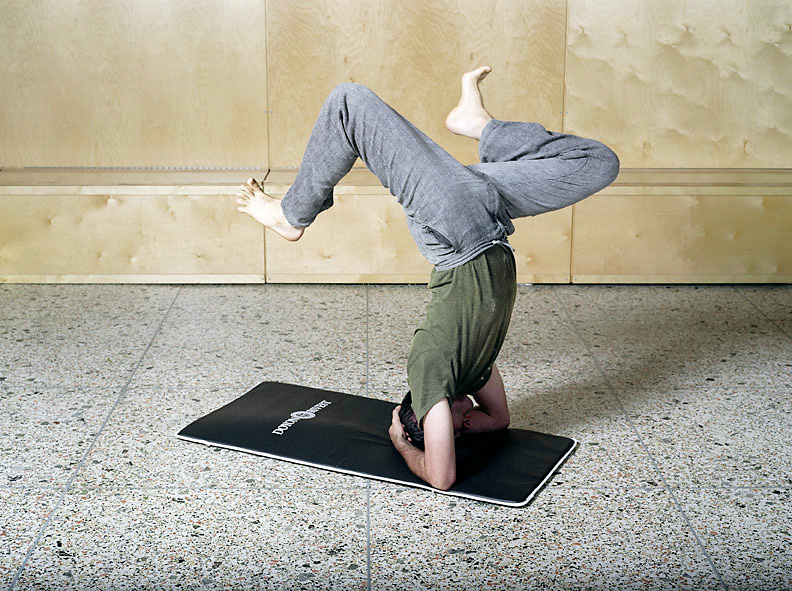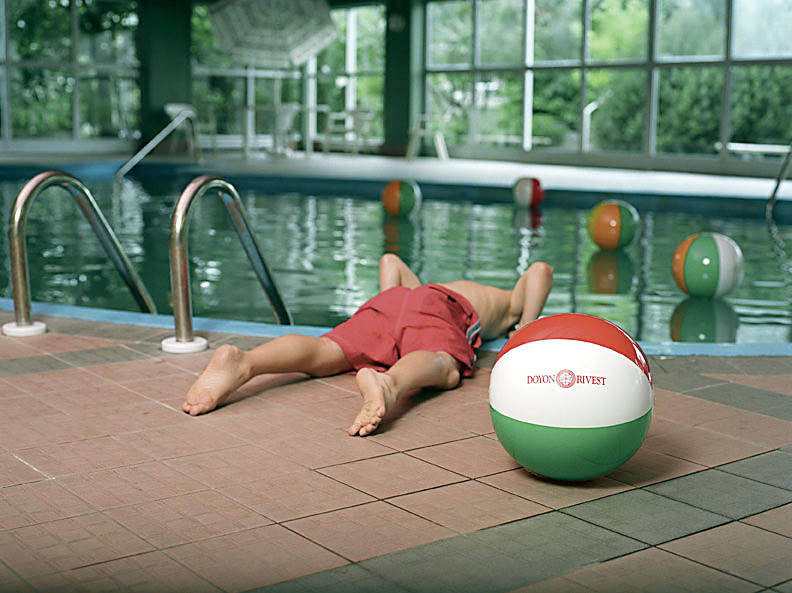[Spring 2006]
Doyon-Rivest
thanks for being there
October 27–November 26, 2005
Gallery TPW
The work of Doyon-Rivest asks the simple question, If the world of advertising can exploit art and artists for financial benefit, then why can’t artists appropriate the tools of advertising in their art practice? When you set aside the alleged lofty goals of art and base ends of advertising, you can see at least a hint of self-promotion in the work of any artist with a reputation, and surely a good ad betrays some small spark of the inspiration that drives artists. Doyon-Rivest merely connects the dots.
As a kind of two-man art-collective-cum-faux-advertising agency, Quebec City–based Mathieu Doyon and Simon Rivest began putting the styles and techniques of print advertising to use in 2001, conflating the difference between art and ads in the process. During Artefact 2004 in Montreal, their billboards displaying the generic Doyon-Rivest globe logo and an image of the Mont Royal location in which they were placed were, perhaps, a little too clever, upsetting some people who believed the realistic displays were actually advertisements. But outright deception has never been their intent, and they do not seek to use advertising satirically as a critique of consumer culture. They merely pragmatically employ advertising as a neutral tool in their art in order to promote it.
Honing its approach, in “thanks for being there” Doyon-Rivest has stripped its work of some of the most obvious hallmarks of advertising in order to play up the ambivalence between ads and art, triggering our automated response to the language of advertising. In effect, the artists maintain just the semblance of advertising, using its power to promote their “brand,” while ensuring through the subtle use of humour that we still recognize the work as art.
The fascinating thing about the show becomes watching them strive to strike this fine balance. Standing in the doorway of the gallery, the first thing one notices is the small red, green, and white beach balls littering the floor, each emblazoned with the logo. On a brown wall are seventy-five portraits of bland-looking, random people sitting in front of fake wood panelling. As one follows the brown wall around the corner, stepping over more beach balls, it becomes clear that this part of the show comprises the firm’s fake market research, making the portraits, perhaps, a target market. Large, bold, italicized white-vinyl lettering applied to the wall reads, “Knowing is Half the Battle,” an empty platitude borrowed from the popular 1980s cartoon G.I. Joe.
Punctuating the end of the phrase, a small projection of banal images flickers by: a van, a plate of food in a nondescript mall food fair, dogs in a tennis court. Every so often the image pauses on pastel blue and pink graphs. Each expresses with great seriousness psychographic measurements of absolutely nothing meaningful, often hilariously. An unnamed bar graph measures control, politeness, and fear, without any indication why. A mysterious pie graph is two-thirds spirituality with one-sixth regret and one-sixth escape. The best one, which will keep one up at night if one thinks about it too much, shows the bivalent connection between two boxes labelled creativity and pity.
If knowing is half the battle, the other half consists in selling a corporate identity. Nine large digital prints do just this, expertly mounted under Plexiglas. With their slick look, visible Doyon-Rivest logos, and aesthetically pleasing balance of colour and composition, they insist on being seen as advertising, yet undermine their own identity. Because the logos have been removed from the surface of the image, where they appeared in Doyon-Rivest’s earlier works, and placed instead on random-seeming objects in the image, they destabilize the illusion of advertising just enough for the viewer to see the glossy pictures as art. Taking the show in as a whole, our ad-savvy minds insist that no one logo could belong on such disparate things as shower curtains, catamarans, floor mats, and drum kits.
As it does with the projection, humour also plays a role in disclosing the function of the image. On the edge of a pool we see a boy lying on his stomach peering over the water. The pool is littered with the same beach balls as on the floor of the gallery, and one sits in the foreground with its logo facing the camera. On the Doyon-Rivest floor mat, we see a man performing a headstand, barefoot, his toes curled with concentration and his face hidden in shadow. Curiously, both these images and others hide the faces of the people they capture, a technique that frustrates the viewer’s attempt to connect with the subject, sending us looking for more visual cues to read the image.
One of two off-site extensions of the show, at the hotel-based Toronto Alternative Art Fair International, allowed Doyon-Rivest to interact with the public at large, much as they did on Mont Royal. Strolling past the Drake Hotel on Queen West during the fair, you would have seen a large, drab, grey banner hanging above the hotel’s upstairs patio. Four men and two women, standing in rather bad lighting, each wear Doyon-Rivest visors and neutral expressions on their faces. Are they Doyon-Rivest employees or customers – and, if customers, of what? Is the visor the product, or a free perk that comes with the purchase of a product? Passers-by left unsure whether they are looking at art or an ad will nonetheless recall the Doyon-Rivest logo the next time they see it, and that, it seems, is the key. In the fake firm’s response to advertising using art, art becomes advertising for the artist.
At heart, the work structures itself on a play of form and content. Using the form of advertising as a static element, content becomes the variable with which Doyon-Rivest plays, making the product just strange enough to frustrate our mundane, automated response to advertising. But the truly subversive aspect of the artists’ work lies in their bald appropriation of art to sell themselves. Next to Doyon-Rivest, all art betrays a trace of self-promotion, the signature of the artist becoming just another logo. As art critiquing itself as advertising, Doyon-Rivest inadvertently issues a challenge worth responding to.
Kevin Temple is a contributor to NOW Magazine in Toronto and has written for The Globe and Mail, Canadian Art, University of Toronto Magazine, and Hive, among others.


